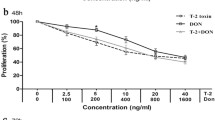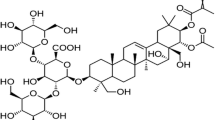Abstract.
Objectives: To investigate the mechanisms of action underlying the anti-inflammatory action of aceclofenac in vivo, we studied in vitro the effect of aceclofenac and its main metabolite, 4′-hydroxyaceclofenac, in comparison with diclofenac, another metabolite, on cyclooxygenases activity as well as interleukin-1β, -6 and -8, nitric oxide, and prostaglandin E2 production by human osteoarthritic and normal articular chondrocytes. Methods: Enzymatically isolated human chondrocytes were cultured for 72 h in the absence or presence of interleukin-1β (IL-1β) or lipopolysacharride (LPS) and with or without increased amounts (1 to 30 μM) of aceclofenac or metabolites. The production of different cytokines was measured by Enzyme Amplified Sensitivity Immunoassays (EASIA). Prostaglandin E2 was quantified by a specific radioimmunoassay. Nitrite and nitrate concentrations in the culture supernatants were determined by spectrophotometric method based upon the Griess reaction. Cyclooxygenase-2, inducible NO synthase and IL-1β gene expression were quantified by reverse transcription of mRNA followed by real time and quantitative polymerase chain reaction. Finally, cyclooxygenase inhibitory potency of the drugs was also tested in both a cell-free system using purified ovine cyclooxygenase-1 and -2 (COX-1 and COX-2) and at a cellular level using human whole blood assay. Results: We have demonstrated that aceclofenac, 4′-hydroxyaceclofenac and diclofenac significantly decreased interleukin-6 production at concentrations ranged among 1 to 30 μM and fully blocked prostaglandin E2 synthesis by IL-1β- or LPS-stimulated human chondrocytes. Aceclofenac and diclofenac had no effect on interleukin-8 production while 4′-hydroxyaceclofenac slightly decreased this parameter at the highest dose (30 μM). Aceclofenac was without effect on IL-1β- or LPS-stimulated nitric oxide production. At 30 μM, 4′-hydroxyaceclofenac inhibited both IL-1β or LPS-stimulated nitric oxide production while diclofenac inhibited only the LPS-stimulated production. Finally, at 30 μM, the three drugs significantly decreased IL-1β mRNA. In the whole blood test, aceclofenac and 4′-hydroxyaceclofenac weakly inhibited COX-1 with IC50 values superior to 100 μM, but decreased by 50% COX-2 activity at the concentration of 0.77 and 36 μM, respectively. Diclofenac strongly inhibited both COX-1 and COX-2 with IC50 values of 0.6 and 0.04 μM, respectively. On the other hand, aceclofenac and diclofenac weakly inhibited purified ovine cyclooxygenases with IC50 values superior to 100 μM, whereas 4′-hydroxyaceclofenac was without effect. Conclusions: These results suggest that aceclofenac actions are multifactorial and that metabolites could contribute to its anti-inflammatory actions.
Similar content being viewed by others
Author information
Authors and Affiliations
Additional information
Reveived 30 November 2000; returned for revision 8 January 2001; accepted by W.B. van den Berg 5 April 2001
Rights and permissions
About this article
Cite this article
Henrotin, Y., de Leval, X., Mathy-Hartet, M. et al. In vitro effects of aceclofenac and its metabolites on the production by chondrocytes of inflammatory mediators. Inflamm. res. 50, 391–399 (2001). https://doi.org/10.1007/PL00000261
Issue Date:
DOI: https://doi.org/10.1007/PL00000261




